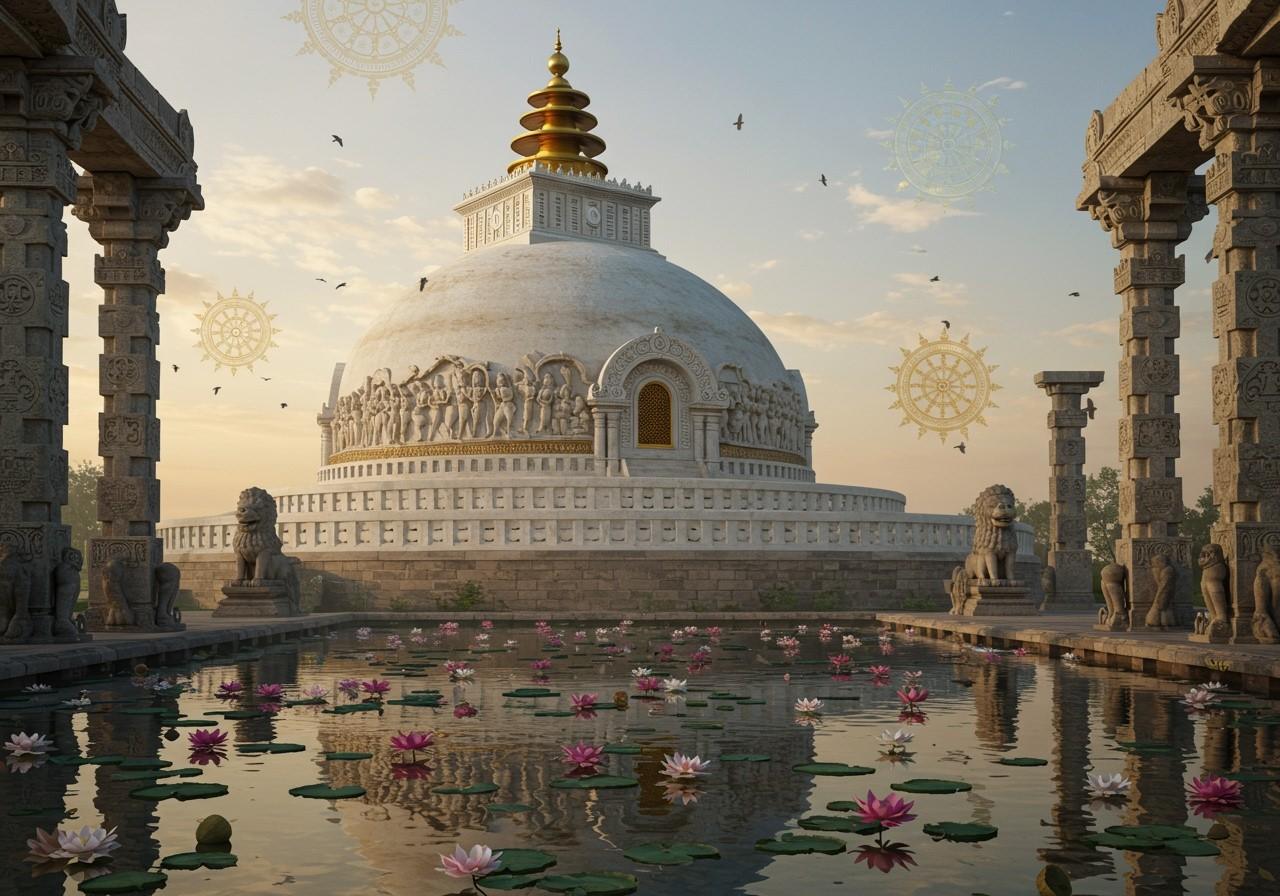
The Amaravati Stupa, also known as the Mahachaitya, stands as a testament to India’s rich Buddhist heritage. Located in Amaravathi village, Guntur district, Andhra Pradesh, this ruined yet magnificent monument holds profound historical, architectural, and artistic significance. It was built in phases between the third century BCE and about 250 CE. This blog delves into its origins, construction, unique features, and artistic contributions, offering a glimpse into the spiritual traditions of ancient India.
Unveiling the Amaravati Stupa
Rediscovering a Lost Treasure
- Initial Discovery: In 1797, Major Colin Mackenzie, the first Surveyor General of India, stumbled upon the remnants of the Amaravati Stupa, bringing it back to light after centuries of obscurity. This marked the beginning of a renewed interest in this ancient site.
- Subsequent Excavations and Documentation: Further excavations by Sir Walter Elliot in 1845, followed by meticulous documentation by Sir Alexander Cunningham, the founding director of the Archaeological Survey of India, and later explorations by Robert Sewell in the 1880s, gradually revealed the stupa’s historical and artistic importance.
- Preservation Efforts and Challenges: Local historians played a crucial role in preserving the site, facing challenges such as the removal and relocation of artifacts to museums around the world. Today, the site is protected by the Archaeological Survey of India.
The rediscovery and subsequent study of the Amaravati Stupa have been instrumental in understanding the evolution of Buddhist architecture and art in India, providing valuable insights into the religious and cultural practices of the time.
Construction and the Visionaries Behind the Amaravati Stupa
From Concept to Creation
- Patronage and Purpose: The Amaravati Stupa’s construction began under the patronage of the Satavahana dynasty, particularly during the reign of King Vasishthiputra Pulumavi, between the third century BCE and about 250 CE. It served as a significant religious center for Buddhist worship, attracting pilgrims and scholars from far and wide.
- Collaborative Craftsmanship: The construction was a collaborative effort involving local artisans and craftsmen who skillfully worked with limestone, the primary building material. The design was likely influenced by Buddhist monks and scholars, ensuring the stupa’s adherence to religious principles. Funding came from the Satavahana rulers and wealthy merchants, demonstrating the importance of the stupa to the community.
Architectural Marvels of the Amaravati Stupa
Distinctive Features and Symbolism
- The Anda and its Significance: The stupa’s most prominent feature is the hemispherical dome, known as the Anda, which symbolizes the universe and the Buddha’s enlightened mind. This dome rests on a drum-like structure, further emphasizing its symbolic importance.
- Vedika: Narratives in Stone: Intricately carved railings, called Vedika, encircle the stupa, depicting various Jataka tales, stories of the Buddha’s previous lives. These narratives in stone provided visual teachings for pilgrims and visitors, illustrating moral and spiritual lessons.
- Harmika and Toranas: Gateways to the Divine: Atop the dome is the Harmika, a square railing representing Buddhist heavens. Four elaborate gateway arches, known as Toranas, adorned with detailed reliefs, mark the cardinal directions and serve as symbolic entrances to the sacred space.
The narrative art carved into the stupa’s railings and gateways illustrates scenes from the life of Buddha, offering a visual representation of his teachings and journey towards enlightenment. The Amaravati Stupa’s innovative architectural design served as a model for subsequent Buddhist structures, influencing the development of stupa architecture across the region.
Artistic Legacy of the Amaravati Stupa
A Canvas of Buddhist Art
- Masterful Sculptures and Reliefs: The bas-reliefs and sculptures adorning the Amaravati Stupa showcase the exceptional skills of ancient Indian craftsmen. The intricate details and expressive figures reflect a high level of artistic achievement, capturing the essence of Buddhist teachings and iconography.
- Symbolic Motifs and Narratives: Recurring Buddhist themes, such as the lotus flower, the wheel of dharma (representing the Buddha’s teachings), and the Bodhi tree (under which the Buddha attained enlightenment), are prominently featured throughout the stupa’s artwork. Narrative panels depict key events from the Buddha’s life, providing a visual chronicle of his journey.
The art of the Amaravati Stupa is renowned for its unique blend of the Gandhara and Mathura artistic styles, incorporating Indian and Greco-Roman elements. This fusion of artistic influences reflects the cultural exchange that took place along the ancient trade routes, enriching the artistic landscape of the region.
Connecting with Buddhist Heritage through Poojn.in
Poojn.in, India’s leading online store for cultural and religious goods, offers a wide selection of products to help you honor and connect with the sacred Buddhist heritage of the Amaravati Stupa. Enhance your personal spiritual practice with authentic ritual items like:
- Buddha Statues: Choose from a variety of pure copper and brass Buddha statues for your home temple or meditation space. These statues serve as a focal point for devotion and contemplation.
- Meditation Cushions and Prayer Mats: Create a comfortable and serene environment for your meditation and prayer practices with our selection of cushions and mats.
- Incense and Holders: Enhance the ambiance of your spiritual practice with traditional incense sticks and beautifully crafted holders.
Visit poojn.in today to explore our complete collection of Buddhist ritual supplies. We offer secure packaging and pan-India delivery. Our customer service team is available to assist you in selecting the most appropriate items for your needs.
Conclusion: The Enduring Legacy of Amaravati Stupa
The Amaravati Stupa remains a powerful symbol of India’s rich cultural and religious past. Its rediscovery and preservation offer invaluable insights into ancient Buddhist art, architecture, and spiritual practices. Thanks to the dedication of historians, archaeologists, and local artisans, the legacy of this magnificent monument continues to inspire and educate. The Amaravati Stupa stands as a testament to the enduring power of tradition and the importance of safeguarding our cultural heritage for generations to come.


